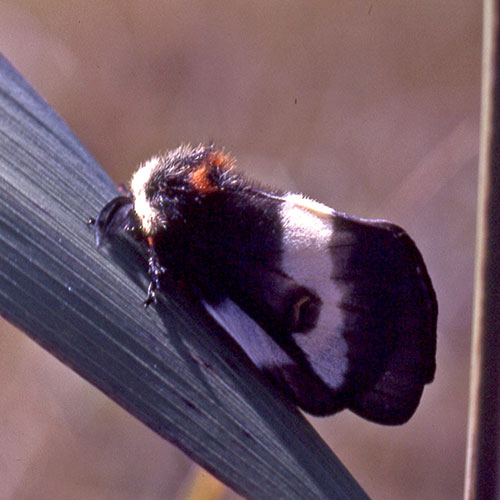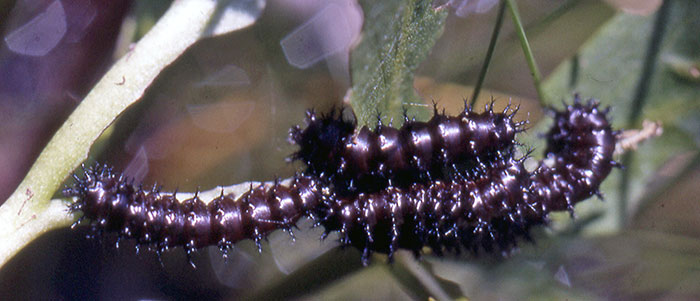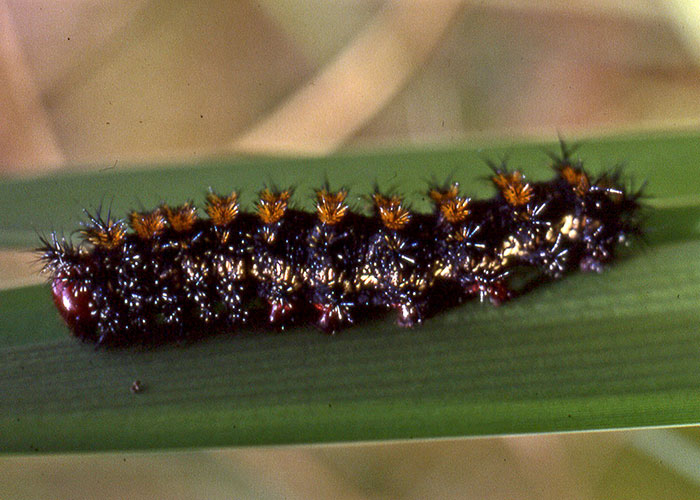Greetings, BugFans,
Buck Moths
One of the BugLady’s favorite moths is the Buck Moth, whose story here in Wisconsin is a complex one. Buck moths are members of the usually-summertime, usually-nocturnally-active silk moth family (Saturniidae, home of the Cecropias and Luna moths), but buck moths are active on warm afternoons in mid-fall. One explanation of their name is that they are out during the hunting season when whitetail bucks are in rut. The Wild Silk Moths of North America passes on another explanation, which has been repeated in folklore since the early 1700’s. Dead bucks were found with a glut of maggots or “bots” in their throats. These eventually [allegedly] turned into “the finest butterfly imaginable, being very large with black, white and yellow stripes.” The theory further clarifies that “bucks breed their [the buck moths] caterpillars in their heads and blow them out their nostrils.”
The BugLady finds buck moths in the Cedarburg Bog in October. Like many of their larger silk moth relatives, the adults do not feed. When they are startled, they are as likely to fold their wings and drop into the vegetation below as they are to fly away. Female buck moths use pheromones to attract males, and the BugLady found tantalizing references to buck moths being attracted to the webs of orb-weaving spiders because of the orb-weavers’ use of “pheromone mimicry.”
Female buck moths lay a cuff of eggs on the twig of a larval food plant in fall, and the eggs hatch in spring. During the first half of their caterpillar-hood, the shiny, black larvae are gregarious and are picky eaters. There is some speculation that a mass of dark caterpillars has both a thermal advantage (dark colors absorb the sun’s rays better and they share their minimal body heat) and an anti-predator advantage (diving into a mass of spiny worms is off-putting). Later, they go their separate ways and choose their food from a broader menu. There are observations of caterpillars swimming from one food plant to another, a sight the BugLady would like to see. Caterpillars pupate in early summer and the adults emerge in fall.
As for the caterpillars? Look but don’t touch. They start out bristly and get bristlier and spinier as they age. Some of the spines are hollow and contain a poison that may cause initial nausea, pain comparable to a bee sting, itching/burning, swelling, and redness that may last more than a week. First aid includes gently applying the sticky side of duct tape to the site to remove spines (good for cactus encounters, too) washing, ice packs and steroid creams. At the risk of stating the obvious, several sources suggest that the best way to avoid receiving stings is to avoid handling caterpillars that have spines.
Eastern Buck Moth
Actually, Wisconsin’s buck moths are a bit of a taxonomic mystery. There are 15+ species of buck moths in the U.S. and most are western. The buck moth that occurs in Wisconsin may be Hemileuca maia, the Eastern buck moth, but it is more likely Hemileuca nevadensis, the Nevada buck moth, or it may be the elusive Midwestern fen buck moth Hemileuca sp. 3, which may turn out to be nevadensis (if nevadensis is indeed a full species) or possibly a new species or an intergrade between nevadensis and maia. The Midwestern fen buck moth is listed as endangered/threatened in a number of Midwestern states despite the fact that its species has not been pinned down. Cutting edge entomology right here on BOTW, once again.
But, you get the picture—it’s a confusing group, and caterpillars are often identified by their food plants. The BugLady is proceeding on the assumption that these are nevadensis, because of the food plant. One theory is that nevadensis, which has an interesting checkerboard range extending north and east from southern California to a few spots in New England, expanded its range into the Midwest post-glacially, and here it adapted to new habitats (areas with high ground water) and new food plants (the fen-loving Buckbean or Bogbean, Menyanthes trifoliata, which is common in the Cedarburg Bog). Maia eats oaks; the western nevadensis eat willow and poplar; the more northern populations of nevadensis add Bog Birch, which is also common in the Cedarburg Bog. Since Bogbean dies back in late summer and Ms. Buck Moth can’t lay her eggs on it, bog birch will do. And then there’s an interesting account of a population of larvae at a site between Milwaukee and Madison eating purple loosestrife.
Stay tuned.
The BugLady


